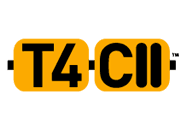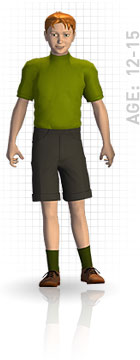
| English Appliances TRAINER System™ T4CII™ | |
NEW TRAINER for Class II Correction™ | ||||||||||||||
|
|
Clinical Applications
A phase I appliance which can be used before and during fixed appliance treatment. The treatment plan can be simplified by the elimination of the incorrect myofunctional habits that often perpetuate the malocclusion and cause relapse of the corrected result with time.
In the majority of malocclusions, the T4CII™ can assist or correct difficult cases, such as open bites and severe malocclusions - before braces - where poor myofunctional habits are present.
The T4CII™ can be used with upper fixed brackets only, which allows the lower anteriors to align due to soft tissue improvements, and may save the need for lower brackets. The T4CII™ can still be used during the lower fixed phase as required or can be substituted with other preferred Class II adjunctive treatment.
Shields the soft tissue from braces - For Treatment of soft tissue dystrestia its higher flanges are better than the T4K™/T4B™ in more severe malocclusions. Trauma of the soft tissue is a common problem when fixed appliances are first applied. The T4B™ covers the offending braces eliminating much of the trauma to the patient in those first few weeks of fixed treatment. In addition the soft tissue (lips and cheeks) are protected from the irritation of the brackets and wire which cause discomfort in the initial stage of orthodontics.
Pre-treatment for Class II correction - The combination of preventing tongue thrusting and changing mode of breathing assists Class II correction, continuing through braces phase and upper fixed braces to lessen the need for lower braces. Nose breathing increases the horizontal growth of the mandible and normalizes incisor position. A mandibular growth is achieved by changes in mode of breathing; passive maxillary expansion is achieved by change in tongue position plus bite opening. Some passive arch expansion is achieved, greatly assisting the Orthodontist in non-extraction cases.
Jaw development, Jaw alignment - Is produced when in place (same as most functional appliances) to assist in Class II correction. The combination of prevention of tongue thrusting and changing mode of breathing assists Class II correction. The correction of mouth breathing is one of the most important factors in maintaining maxillary arch expansion which can be lost in the fixed appliance stage.
Habit correction – The tongue tag actively trains the positioning of the tongue tip as in myofunctional and speech therapies, tongue guard stops tongue thrusting when in place and forces the child to breathe through the nose, lip bumper to discourage over-active mentalis muscle activity.
Open bite - Simply by removing the detrimental effect of the tongue and the peri-oral musculature on the anterior dentition, prior to regular orthodontic treatment.
Severe crowding - Arch length gained by reducing the effect of the overactive mentalis muscle. The facial improvement is achieved by changing mode of breathing and passive arch expansion from change in tongue position.
In the majority of malocclusions, the T4CII™ can assist or correct difficult cases, such as open bites and severe malocclusions - before braces - where poor myofunctional habits are present.
The T4CII™ can be used with upper fixed brackets only, which allows the lower anteriors to align due to soft tissue improvements, and may save the need for lower brackets. The T4CII™ can still be used during the lower fixed phase as required or can be substituted with other preferred Class II adjunctive treatment.
Shields the soft tissue from braces - For Treatment of soft tissue dystrestia its higher flanges are better than the T4K™/T4B™ in more severe malocclusions. Trauma of the soft tissue is a common problem when fixed appliances are first applied. The T4B™ covers the offending braces eliminating much of the trauma to the patient in those first few weeks of fixed treatment. In addition the soft tissue (lips and cheeks) are protected from the irritation of the brackets and wire which cause discomfort in the initial stage of orthodontics.
Pre-treatment for Class II correction - The combination of preventing tongue thrusting and changing mode of breathing assists Class II correction, continuing through braces phase and upper fixed braces to lessen the need for lower braces. Nose breathing increases the horizontal growth of the mandible and normalizes incisor position. A mandibular growth is achieved by changes in mode of breathing; passive maxillary expansion is achieved by change in tongue position plus bite opening. Some passive arch expansion is achieved, greatly assisting the Orthodontist in non-extraction cases.
Jaw development, Jaw alignment - Is produced when in place (same as most functional appliances) to assist in Class II correction. The combination of prevention of tongue thrusting and changing mode of breathing assists Class II correction. The correction of mouth breathing is one of the most important factors in maintaining maxillary arch expansion which can be lost in the fixed appliance stage.
Habit correction – The tongue tag actively trains the positioning of the tongue tip as in myofunctional and speech therapies, tongue guard stops tongue thrusting when in place and forces the child to breathe through the nose, lip bumper to discourage over-active mentalis muscle activity.
Open bite - Simply by removing the detrimental effect of the tongue and the peri-oral musculature on the anterior dentition, prior to regular orthodontic treatment.
Severe crowding - Arch length gained by reducing the effect of the overactive mentalis muscle. The facial improvement is achieved by changing mode of breathing and passive arch expansion from change in tongue position.
More Information
Recommended minimum use - ONE HOUR DAILY plus OVERNIGHT WHILE SLEEPING
If T4K™ has a retention problem, use T4CII™. This makes it a seamless phase I and II treatment integrating with your current orthodontic techniques. No need to change the appliance.
For best results, start with the T4CII™ 3-6 months prior to the eruption of the permanent dentition, then when the upper permanents are present, apply upper fixed, but delay the lower fixed for 6 months. This will allow the lower anteriors to align due to soft tissue improvements and may save the need for lower brackets. The T4CII™ can still be used during the lower fixed phase as required or can be substituted with other preferred Class II adjunctive treatment.
For best results, start with the T4CII™ 3-6 months prior to the eruption of the permanent dentition, then when the upper permanents are present, apply upper fixed, but delay the lower fixed for 6 months. This will allow the lower anteriors to align due to soft tissue improvements and may save the need for lower brackets. The T4CII™ can still be used during the lower fixed phase as required or can be substituted with other preferred Class II adjunctive treatment.

PWG 4.BRACES |
Appliances in the Braces Series™ are not mouthguards. Therefore they are not suitable for use while playing sports.
For GENUINE PROTECTION DURING SPORT: POWRGARD® 4•BRACES™ is |
Protection of the anterior teeth and the TMJs is important during sport. The POWRGARD® 4•Braces™ was the first sports mouthguard specifically designed for braces, offering genuine protection where it is needed most — over the upper anterior teeth and the TM Joints. It also has a tongue tag to actively retrain the tongue. Retention is excellent. Also available in double arch version.
For more details visit |
Arch Development
In conjunction with the TRAINER System™
 |
The Farrell BENT WIRE System™ |
Visit THE MRC Library
Manuals, articles, brochures and instructional material
 |
Library Downloads |

